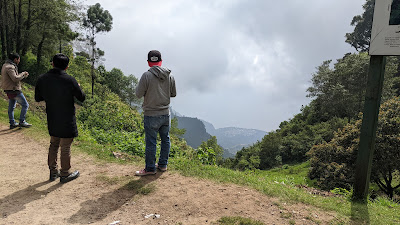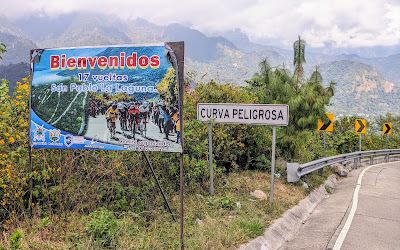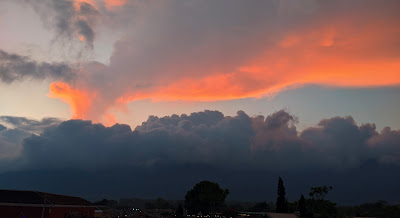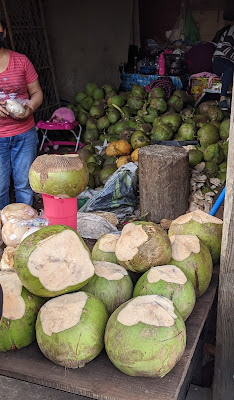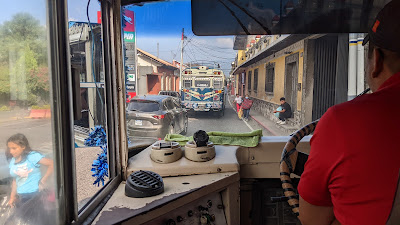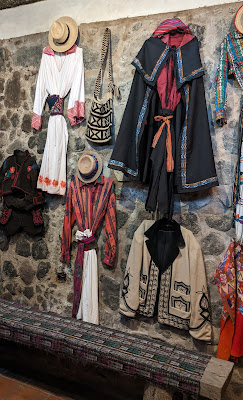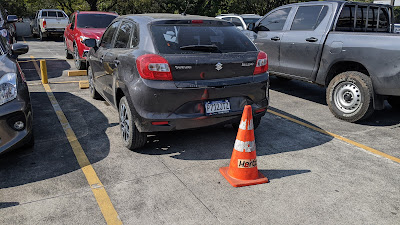After seven nights on Lake Atitlán it was time to break camp at Casa Byron and head back direction Guatemala City. When I had initially planned the trip I of course knew that my flight back to the US would not leave until mid-afternoon, so it offered itself to spend a couple of nights in Antigua, Guatemala's capital until the earthquake of 1773, and drive the remaining 45 kilometers to the airport on the day of my departure.
Once I had navigated the jeep road from Tzununá to San Marcos the surface smoothed out, but it still wasn't any high-speed driving. If I remember right, the first 20 kilometers that day took well over an hour. All the small villages feature brutal speedbump after speedbump. One cannot go fast, period. There always seem to be some detours, and one can only trust one's sense of direction (and the GPS) that the detour will eventually rejoin the original route.
 |
| Lake Atitlán from above—obscured by clouds and fog |
Driving from the lake up to Santa Clara de Laguna (where I had ended my hike after visiting La Nariz del Indio) was quite an experience. The road climbs about 2,500 feet within just a few kilometers, one tight serpentine after the other. It was like going up L'Alpe d'Huez, just steeper, much steeper. I cannot believe that this road is part of the Vuelta a Guatemala, a UCI 2.2 event that was last run between October 23 and November 1 of this year as a 10-stage race. Hello, ITA, what about sending me down here at some point in the future? When I checked out the race results it was clear that (most of the) European and US teams avoid such races; there was one obscure Dutch team that had riders in the results, and they probably felt just as much out of their comfort zone as the gringo teams at the 2015 Vuelta Independencia Nacional Dominicana in the DR on which I reported extensively.
Onward I drove, the entire time at elevations between around 6,500 to 8,000 feet. Often I was in the clouds, or better, the fog that exists in these parts where warm tropical air rapidly has to ascend. Man, it was a fascinating drive! I stopped a few times along the way to snap a photo and marvel at this incredible landscape.
Onward I drove, the entire time at elevations between around 6,500 to 8,000 feet. Often I was in the clouds, or better, the fog that exists in these parts where warm tropical air rapidly has to ascend. Man, it was a fascinating drive! I stopped a few times along the way to snap a photo and marvel at this incredible landscape.
Eventually I ended up on the Panamericana, yes, the CA-1 that has nothing to do with California, and simply flowed along with the big trucks and chicken buses, scaled-down versions of which are being sold in roadside stands. By midafternoon I finally reached Antigua, and on horrific cobblestone streets I approached the Hotel Nolasco, just a few blocks away from the city's main square and cathedral. I had chosen this hotel for location, price, reviews, and the fact that it offered free off-the-street parking, something that one has to think about when renting a car. You wouldn't have known that there was a hotel on the other side of the ancient wooden gate; had it not been for a tiny house number and the small letters nolasco I would have doubted my GPS. Ringing the bell brought out the proprietor, yet another Jorge, a friendly man with whom I struck up a nice relationship during my short stay. The gate swung open and the tricky park job into the courtyard ensued. It was obvious that Jorge knew exactly at what point I would have to turn the steering wheel just a tad more to avoid this planter, that big rock. No scratches. Whew!
The tiny Hotel Nolasco has maybe three or four guestrooms, possibly more. I heard some other guests arrive and leave and there were another two cars at one point, but the place felt much more like being at some friends' cottage and enjoying the garden and courtyard. What a wonderful place! It was quiet, clean, comfortable, and friendly, right in the middle of the city yet worlds away from the busy-ness outside. And all that for less than $50 a night, including a lovely breakfast prepared and served by a smiling young woman who enjoyed to chat with me and didn't mind my polite request for maybe a third cup of coffee. Oh, those beautiful faces in Guatemala!
To keep things stylish, my bathroom featured the ever-popular electrical shower, a contraption that's ubiquitous especially in South America but can also be found in Centro America. This one, fortunately, was hard wired and I did not have to connect two hot wires while standing in a wet tub to turn it on. Think of the exact opposite of an old-fashioned immersion heater, if you have ever seen one: Water runs through it and during this flow is heated by a coil. The shower has only one knob, and the speed with which water flows governs how warm it can get. It's really a fairly clever system although this one produced hot water only if I dialed the waterflow way down to a faint trickle. I probably did not get electrocuted thanks to the protective icons in the bedroom.
 |
| I love refried beans in the bag! |
 |
| 10 quetzal are about $1.30, and many items cost as much as in the US or more |
I spent my first evening strolling through town, buying a few bags of spice mixes for pollo pipián as well as jocón, two traditional Mayan dishes. Just going to a local supermarket is so much fun! I watched the spectacular sunset from the rooftop terrace of Antigua Brewing Co., just a few kilometers away from the volcano that in 1773 had caused so much damage that the citizens decided to relocate the capital to what is now known as Guatemala City. It was a beautiful spot to watch the wild cloud formations in the setting sun, and the beer was rather good! As it turns out, Antigua has three distinct microbreweries, one of which has two locations. The beer scene is alive and well here.
For the rest of the evening I walked around town, successfully avoiding a sprained ankle or worse on the unforgiving cobblestones. Antigua really appears old, no, ancient. There are walking tours, many art galleries, Christmas decorations, women selling corn-o-the-cob roasted on a tiny grill. The little traffic there is moves slowly as not to damage the vehicle. The only thing that wasn't perfect was my dinner, which was only memorable for the location: Somehow I had ended up in a restaurant in which an AA or religious men's meeting was held, and the novelty of the preaching and praying soon dissipated. Oh well, not everything can be perfect.
My plans for the following day started to crystallize during my breakfast at the hotel when I found some Free Walking Tours (they're not really free as one pays the guide a tip) that were still available for the day. I chose an excursion that promised an informative exploration of Antigua's market and then a chicken bus trip to an outlying village, San Antonio Aguas Calientes, where we would stop by a textile shop, followed up by a visit to the oldest cathedral in all of Guatemala. This three-hour long excursion sounded perfect and right up my alley, especially after my great experience with Francisco, my guide on my hike from San Pedro.
For the rest of the evening I walked around town, successfully avoiding a sprained ankle or worse on the unforgiving cobblestones. Antigua really appears old, no, ancient. There are walking tours, many art galleries, Christmas decorations, women selling corn-o-the-cob roasted on a tiny grill. The little traffic there is moves slowly as not to damage the vehicle. The only thing that wasn't perfect was my dinner, which was only memorable for the location: Somehow I had ended up in a restaurant in which an AA or religious men's meeting was held, and the novelty of the preaching and praying soon dissipated. Oh well, not everything can be perfect.
I arrived at the meeting point with 10 minutes to spare, and the guide, Galileo, showed up a few minutes later. He told me that we were waiting for two more people, two British chicks who would have blended into the crowd at London's Camden Locks with their monstrous platform shoes, many piercings, and multi-colored hair. They arrived more than 20 minutes after our meeting time, in no obvious hurry. Oh well. The four of us started to slowly walk to the nearby market, and instead of pointing out some of the more exotic fruit and herbs Galileo showed off avocados, bananas, and papayas. This didn't start out very well. More than an hour after the start of our tour I had learned nothing yet.
The market is adjacent to the chicken bus terminal, where we headed next to board a bus to San Antonio. The term chicken bus is a gringo moniker for what the locals call la camioneta, reflecting the realities of rural transportation where one needs to take many belongings along, which can often involve chickens and other livestock. The interesting part is that pretty much all of the chicken buses originated in the US where they served as school buses for a few hundred thousand miles before being sold to consolidators who drive them all the way to Guatemala and sell them for a few thousand dollars. The new owners overhaul the engines, give the vehicles new, happy paintjobs, add much chrome and more lights, and—funds permitting—customize the interiors with elaborate stereo systems and even flat screen TVs. It is obvious that the owners/operators take great pride in their buses as they can often be spotted with a rag, polishing the chromed bits and cleaning the windshields.
Before we left the station numerous vendors entered the vehicle and tried to interest the passengers in whatever they were hawking. Some of them stayed on for a short while after our eventual departure. The most interesting one of them was definitely the fat fellow who deftly held three dripping ice cream cones in his right hand, trying to avoid leaving sticky mementos on people's clothes, while using his left hand to stabilize himself while the bus was rocking to and fro. He finally left with all three cones still in his hand.
The ride to San Antonio took maybe 20 minutes; regardless of distance, the fare paid by everyone was five quetzal, or 65 cents, which was being collected by an assistant (el brocha) who was also in charge of stowing or retrieving luggage on the roof, accessed by a ladder at the aft end of the bus. On the return trip later in the afternoon I noticed that there are no set times for the buses to leave; similar to what I had observed with the lanchas at the lake the driver (el chofer) would wait for a few more passengers to show up to make it worth his while to finally start. One can hail the buses pretty much anywhere along the route they travel, and they can be distinguished by their names (typically a woman's name or that of the bus line in case of the bigger outfits) or in some cases the destination.
 |
| National Tour Guide extraordinaire Galileo entering the chicken bus, tour sign in hand |
Galileo requested a stop on the outskirts of the village, and this was where the most interesting part of our tour was to unfold. We crossed the street and entered a small courtyard where colorful textiles were displayed. A middle-aged Mayan woman greeted us and welcomed us to the Centro Artesanal de San Antonio Aguas Calientes. In surprisingly good English she gave us an introduction into the art of weaving. I was totally surprised how long it takes to create even small pieces; she said that the cloth that she was working on had been in the making for about six weeks. The central red area had about 320 vertical threads, and each array of colors on the right and left added about another 70 threads for a total of almost 500 vertical threads. It was simply amazing to see her work the pattern.
Inside the adjacent house, part of which she called un museo, featured typical clothing items from the village and surrounding area. She proudly showed a large, shawl-like piece that was double-sided so that there's not an inside or outside. Incredible workmanship and design! She said that to this day practically all young women in the village who want to get married will have to produce such a piece; unfortunately I do not recall the Mayan name. The girl has one year to complete it, which serves a bit like a test of "how skilled of a weaver is my future daughter-in-law." She will spend five to six hours every day in addition to all the other work she has to do, and upon completion of the piece she will present it to her mother-in-law, who, in turn, will wear it to church and on special occasions. When the mother-in-law is really pleased, she will place it on top of her head while in public, as if to demonstrate what a fine daughter-in-law she has. And yes, this is still happening today.
The woman told us that before the pandemic between 20 to 25 women were part of their lose co-op, making extra money by selling their handicraft to the many tourists that would pass through. But then came COVID, and the tourists stayed away. Now the pool of weavers has shrunk to just five or six women, and one of them has to always mind the store because there is not enough business to hire someone full-time. She was extremely gracious in face of this calamity, and it was not as if she was trying to pressure us into buying something. How impressive is it to be so factual, so calm, and so convinced that everything will be just fine? Despite my self-imposed moratorium on purchasing travel trinkets I bought two small woven pieces that I will use to keep tortillas warm when the occasion arises, knowing that my money went to real, hard-working artisans.
From here we slowly walked downhill into the village proper. You'd think that a guide (national guide!) would chatter away with interesting information, but none of that happened. We walked by three fellows who were loading unfished coffins on a pick-up truck (cost: about $180, but they still need to be painted, as one of them told me, and that doubles the price), and we also passed by two public laundry stations where women undoubtedly gossip about their daughters-in-law while hunched over the stone basins. The church was closed, and soon it was time to leave once again. What a weird excursion.
We found a return camioneta but before reaching Antigua we exited in Ciudad Vieja where the oldest cathedral in Guatemala is located. Galileo threw around a few dates but mainly talked to himself while walking down the street. We unceremoniously went inside but completely ignored the adjacent monastery. I had made up my mind: I was not going to go back with the group. I gave Galileo $10 and headed off by myself as I had remembered that Ciudad Vieja, the oldest part of Antigua, is home to Cerveceria Catorce, and I wasn't going to miss visiting another brewery.
We found a return camioneta but before reaching Antigua we exited in Ciudad Vieja where the oldest cathedral in Guatemala is located. Galileo threw around a few dates but mainly talked to himself while walking down the street. We unceremoniously went inside but completely ignored the adjacent monastery. I had made up my mind: I was not going to go back with the group. I gave Galileo $10 and headed off by myself as I had remembered that Ciudad Vieja, the oldest part of Antigua, is home to Cerveceria Catorce, and I wasn't going to miss visiting another brewery.
After a couple of beers and a snack I left, found myself a chicken bus back to the city center, and used the afternoon to spend my last cash quetzal on ceviche in the market and looking at the Christmas wares that took up an entire section of the market.
With the sun slowly setting the colors of the market were at their best. Outside of the established covered stall areas men and women were sitting on the bare ground with the last of their wares to sell. A family of four on a motorcycle were heading home with their purchases. Out of nowhere a festive tuk-tuk parade appeared. The afternoon ended well.
Later that evening, as I mentioned, I took in the friendly ambience at Antigua Cerveza's El Bosque branch where young folks congregated to listen to music while huddling around the open fireplace.
By the time I left (hey, who can say no to three pints for 10 quetzal during hora feliz?) it had turned dark. For my final meal in Guatemala I found a fitting restaurant, housed in an old general store that was part of a small estate. It was so stylishly decorated that you would have thought this was a five-star restaurant, but the bill was less than I would have expected surrounded by such ambience. Before my meal arrived I checked out the rooftop dining area (no service up there fairly late on a Thursday night) and the beautiful inner courtyard. For once I had chosen well; no dining table prayers!
The next day, Friday, I took farewell from Jorge in the Hotel Nolasco and drove the final 45 kilometers to the airport, a trip that took almost twice as long as anticipated thanks to stop-and-go traffic. But I had allotted enough time for such eventualities. I dropped off the rental car without any scratches, documented the hand-over on my phone, received my deposit back, and then was off to the terminal. Pre-departure I spent a pleasant hour in the classy Casa del Ron (Priority Pass lounges generally are not that nice!) with superb pulled pork tacos and a few gin & tonics to kill for before heading back to Dallas.

